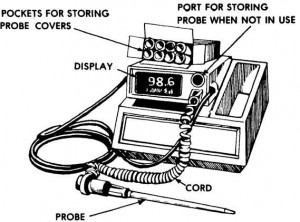An electric thermometer may be battery-powered or plug into an electric outlet.
The operating instructions will vary from one model to another. Therefore, you must be familiar with the operating instructions for the thermometer that you will be using. Pay special attention to the “warm up” requirements.
a. Probe.
The electric thermometer uses a metallic sensing device called the probe. The probe is like the mercury in a glass thermometer in that the probe absorbs heat from the body tissue that surrounds it. An electric thermometer usually has two probes.
The probe that is color-coded blue is used to take oral temperatures. The probe that is color-coded red is used to take rectal temperatures. Both probes are usually the same shape and size.
b. Probe Cover.
Just as the mercury in a glass thermometer never actually touches the patient, a probe is kept from touching the patient’s body by a probe cover. The cover is usually made of paper and is discarded after one use.
The probe cover gives the electric thermometer a great advantage over glass thermometers in that the electric thermometer is ready to be used again once that the used cover is disposed of and replaced by a new probe cover. A glass thermometer, on the other hand, must be cleaned and sterilized before being used again.
c. Display.
The probe has a cord that plugs into the main body of the electric thermometer. The thermometer body displays the information obtained from the probe. An electric thermometer may have either a digital or a scale display.

(1) Digital display. If the electrical thermometer has a digital display, numerals showing the patient’s temperature will be shown on the screen. The electric thermometer in figure 2-3 has a digital display.
(2) Numerical scale display. A numerical scale display looks much like the temperature scale of a glass thermometer. A permanent temperature scale is displayed and the patient’s temperature is represented by a line. The longer the line is, the higher the temperature reading.
